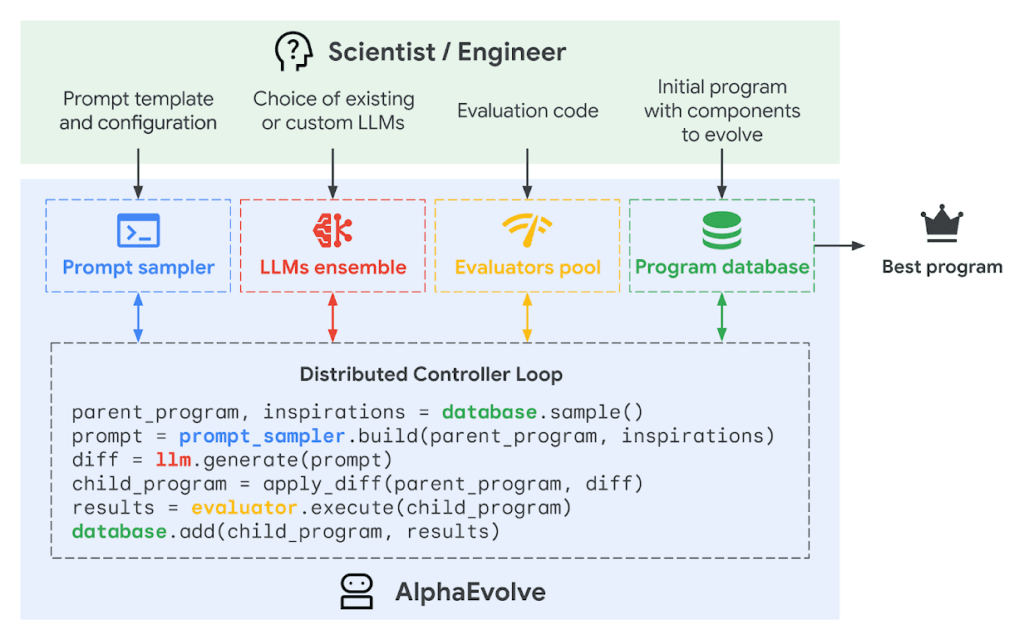Google DeepMind has launched AlphaEvolve, a system that marks a key step toward AI systems that can enhance their own capabilities. By pairing Gemini language models with automated evaluation methods, this system has already saved Google millions in computing costs while solving complex problems that have challenged experts for decades.
How AlphaEvolve Actually Works
AlphaEvolve uses a dual-model approach that few analyses have fully explained. The system relies on Gemini Flash for broad idea generation and Gemini Pro for deeper analysis. This creates a balance between exploration and exploitation – a critical concept in reinforcement learning.
The key technical insight is the evaluation cascade. AlphaEvolve tests new code solutions against progressively harder challenges, quickly filtering out weak options before spending resources on extensive testing. This makes the system much more efficient than brute-force approaches.
What sets AlphaEvolve apart from typical AI coding tools is its ability to modify and evolve entire codebases rather than just generate single functions. The system maintains a database of programs, allowing it to build on past successes through a process similar to genetic algorithms.

The Self-Improvement Loop
The most significant aspect of AlphaEvolve is its self-improvement capability. The system has optimized its own training process, creating what AI researchers call a recursive improvement loop:
- AlphaEvolve identifies bottlenecks in AI training
- It creates optimizations for those bottlenecks
- These optimizations make future AI systems faster and more efficient
- The improved AI systems can then create even better optimizations
This creates a technical flywheel effect that could accelerate AI development. For instance, AlphaEvolve reduced Gemini’s training time by 1% – which sounds small until you consider the massive scale of resources used to train these models.

Business Applications Beyond Google
While Google has deployed AlphaEvolve internally, its approach offers value for many industries:
Manufacturing Supply Chains
AlphaEvolve’s methodology could reshape manufacturing by optimizing complex supply chains. Its ability to balance multiple constraints while finding non-obvious efficiencies could help manufacturers reduce costs and improve resilience.
The system could identify optimal routing, inventory levels, and production scheduling – tasks that human experts often tackle with rules of thumb rather than systematic optimization.
Financial Systems
Trading algorithms and risk management systems involve complex code that must balance speed, accuracy, and safety. AlphaEvolve could find optimizations that human developers miss due to the sheer complexity of these systems.
For example, it could reduce latency in trading systems while maintaining safety checks, or discover more efficient ways to run risk simulations without sacrificing accuracy.
Healthcare Research
Drug discovery and medical research involve computationally intensive tasks like protein folding simulation and molecular dynamics. AlphaEvolve could optimize these processes, potentially accelerating research timelines.
The system could also improve medical image processing algorithms, making diagnostics faster and more accurate without requiring new hardware.
The Technical Breakthrough in Matrix Multiplication
AlphaEvolve’s improvement on Strassen’s algorithm for matrix multiplication is more significant than most reports suggest. This algorithm forms the foundation of countless computing tasks, from graphics rendering to neural network operations.
By reducing the number of required operations from 49 to 48 for 4×4 complex matrices, AlphaEvolve created an efficiency gain that compounds across billions of operations. This type of fundamental improvement is rare in mature fields.
The breakthrough came through what researchers call “non-obvious optimizations” – transformations that don’t follow standard patterns that human experts would typically try. This suggests that AlphaEvolve can find solutions in areas where human intuition has reached its limits.
The Balance of Exploration and Exploitation
A key technical insight in AlphaEvolve is its approach to the exploration-exploitation tradeoff. The system uses Gemini Flash to explore new ideas broadly (exploration) while using Gemini Pro to deepen promising avenues (exploitation).
This mirrors how human research teams often work, with some members brainstorming wild ideas while others refine the most promising concepts. But AlphaEvolve can do this at a scale and speed no human team could match.
The system also employs what researchers call “evolutionary pressure” – systematically preferring solutions with specific characteristics like speed or memory efficiency. This guides the evolution process toward practical solutions rather than just theoretical improvements.
Limitations and Future Directions
Despite its achievements, AlphaEvolve faces significant constraints. It works best on problems with clear evaluation metrics, making it less suitable for tasks requiring subjective judgment.
The system also requires human setup to define the problem space properly. Google researchers spent time crafting appropriate evaluators for each domain – this isn’t a fully autonomous system that can tackle any problem without guidance.
Future versions will likely incorporate more advanced language models, potentially Gemini 3.0 or beyond, which could expand the complexity of problems it can address. Researchers are also working on making the system more accessible to non-experts through user-friendly interfaces.
What This Means for Businesses
For technology leaders, AlphaEvolve represents a shift in how optimization problems should be approached. Rather than relying solely on human experts to find efficiencies, businesses can now consider AI-driven approaches for discovering non-obvious improvements.
This matters most in areas where small efficiency gains translate to major cost savings due to scale – cloud computing, financial services, logistics, and manufacturing. Any business that runs large-scale computing operations should be evaluating how this approach might apply to their systems.
Companies should start by identifying computational processes that:
- Run frequently
- Consume significant resources
- Have clear success metrics
- Have been stable for years without major improvements
These are the sweet spots where AlphaEvolve-like approaches can find hidden efficiencies that have eluded human experts.
What lies ahead
AlphaEvolve points toward a future where AI systems play a more active role in improving their own efficiency and capabilities. While we’re still far from the hypothetical “intelligence explosion” some researchers worry about, this represents a meaningful step toward AI systems that can enhance themselves.
For developers and engineers, this means a shift in role – from writing every line of code to guiding AI systems toward optimal solutions by setting clear goals and evaluation criteria.
The most practical approach for businesses is to start identifying optimization problems that might benefit from this evolutionary approach, while watching how Google continues to deploy these techniques across its massive infrastructure.
As the technology becomes more accessible, companies that have already mapped their optimization challenges will be best positioned to apply these techniques when they become available through cloud services or open-source implementations.
AlphaEvolve may be Google’s tool today, but its approach will likely reshape how optimization problems are solved across many industries tomorrow.


